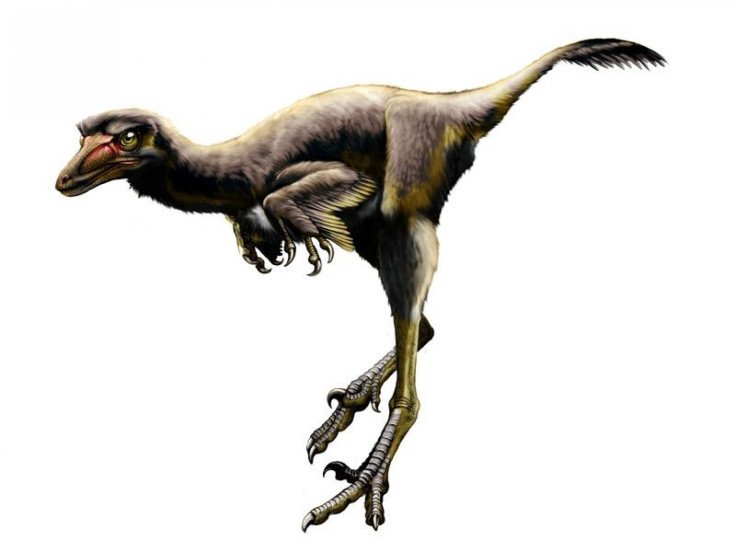Newly Discovered Raptor Had ‘Switchblade’ Claw for Fighting

A new fossil find suggests that a feisty raptor dinosaur didn't just use its sharp claws for show, but may have brandished the hook-like talons as weapons.
The newly unearthed feathered dinosaur, named Talos sampsoni, is a relative of the iconic Velociraptor, made famous in the book and film Jurassic Park. The raptor dinosaurs all had unusually large, sickle-like claws on the second toes of each foot that they held above the ground like folded switchblades.
The 75-million-year-old dinosaur was named Talos for its resemblance to a winged bronze giant in Greek mythology that could run at lightning speed and that succumbed to a wound in his ankle. Sampsoni is in honor of research curator at the Utah Museum of Natural History and contributor to the PBS series Dinosaur Train, Scott Sampson.
The specimen was discovered in the 1.9-million-acre Grand Staircase Escalante National Monument in southern Utah, an area regarded as one of the last pristine dinosaur graveyards in the United States. At least 15 new dinosaur species have been discovered in the area in the past decade, including horned dinosaurs Kosmoceratops and Utahceratops, duck-billed dinosaurs like Gyrposaurus monumentensis, the turkey-like Hagryphus giganteus, as well as two new tyrannosaurs and a collection of armored dinosaurs known as ankylosaurs.
Michael Knell, a doctoral student at Montana State University, stumbled across the remains of Talos while exploring the area for fossil turtles as part of his doctoral research.
I was surprised when I learned that I had found a new dinosaur, Knell told LiveScience. It is a rare discovery, and I feel very lucky to be part of the exciting research happening here in the monument.
A dinosaur with weapons?
Thirty years ago, the fossil of a Velociraptor locked in mortal combat with prey was discovered in Mongolia. Dubbed the fighting dinosaurs, the find suggested that these talons were brandished as weapons.
Thirty years later, Talos sheds more light on how these dinosaurs lived with their weapons.
The new fossil shows foot damage and researchers believe they know why.
This raptor dinosaur specimen is special because it shows evidence of having broken the toe on the foot that bears an enlarged talon, an injury we are interpreting as sustained during combat with other members of the species or in hunting prey, Lindsay Zanno, lead author of a study, told Discovery News.
Zanno is an assistant professor of anatomy at the University of Wisconsin-Parkside and a research associate at the Field Museum of Natural History in Chicago.
Signs are traumas are like gold for researchers as an injured specimen has a story to tell.
Evidence of injury can shed a new light on how a body part was used. For instance, because Talos had signs of trauma on its second toe on its left foot (the one that would have had an enlarged hook-like claw), researchers can uncover new details about the potential function of its toes and claws.
Normally we think that the most pristine fossils we can find perhaps yield the most important information, but in fact sometimes it's the beat-up, damaged, injured specimens that can give you clues about the biology of an extinct animal you wouldn't have otherwise, Zanno told LiveScience.
People have speculated that the talon on the foot of raptor dinosaurs was used to capture prey, fight with other members of the same species, or defend the animal against attack, Zanno said. Our interpretation supports the idea that these animals regularly put this toe in harm's way.
Footprints made by raptors of close relation to Talos suggest that they all held the switchblade talon off the ground while walking.
Who was Talos?
Talos was part of a group of dinosaurs that were closely related to birds, called troodontids. Neither the smallest nor largest troodontid, Talos is estimated to have been roughly 6 feet long, weighing in at about 83 pounds.
Talos was fleet-footed and lightly built. This little guy was a scrapper, Zanno said in the report.
Finding a decent specimen of this type of dinosaur in North America is like a lighting strike, Zanno added. It's a random event of thrilling proportions.
Troodontids are known nearly exclusively from Asia.
The dinosaur was most likely either a carnivore or an omnivore, eating some degree of prey, according to researchers.
While the fossil was discovered in a dry region of America, the landscape that Talos lived in was actually quite different. Talos lived in a warm greenhouse world devoid of polar ice caps.
The area was basically the complete antithesis of what it is now, Zanno said in the report. It was extremely wet then, a very, very lush environment, almost swampy, and regularly bombarded by massive storms coming in off the seaway that divided North America at the time.
The Talos fossil will be on exhibit in the Past Worlds Observatory at the new Utah Museum of Natural History in Salt Lake City.
The complete details of the find were published online Sept. 19 in the journal PLoS ONE.
READ ALSO:
New Times Atlas Grossly Exaggerates Greenland Ice Loss
Dozen New Species of Night Frogs Discovered in India [PHOTOS]
Mysterious Wheel Patterns in Middle East Resemble Peru's 'Nazca Lines' [PHOTOS]
© Copyright IBTimes 2024. All rights reserved.






















